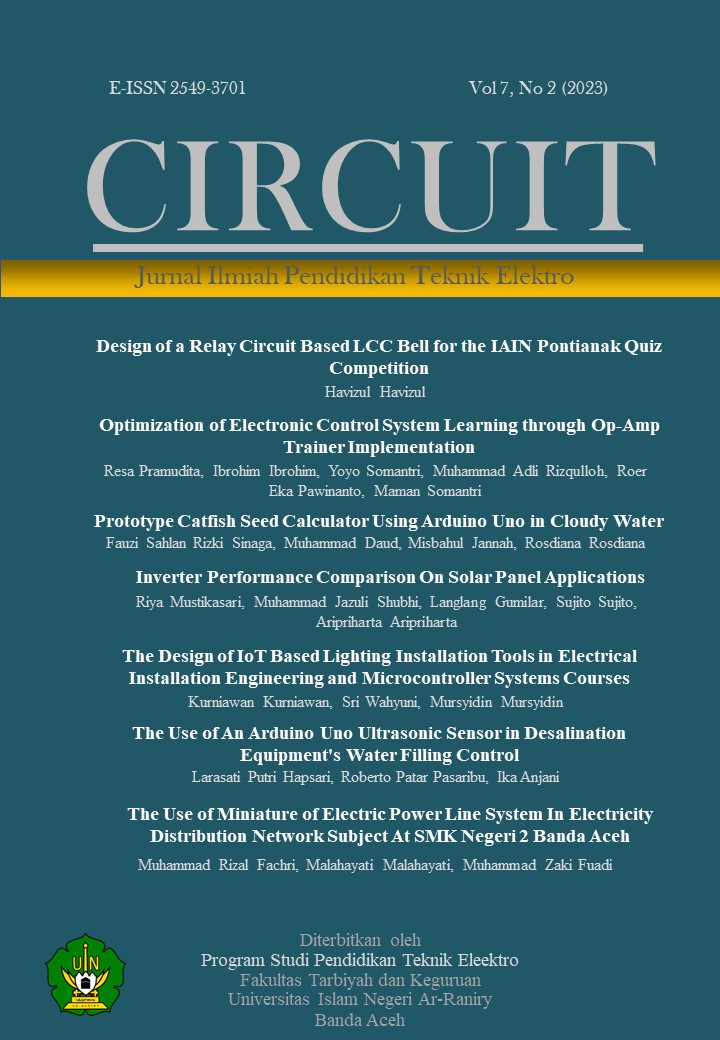The Design of IoT Based Lighting Installation Tools in Electrical Installation Engineering and Microcontroller Systems Courses
DOI:
https://doi.org/10.22373/crc.v7i2.15456Keywords:
Props, Lighting Installation, Internet of ThingsAbstract
Internet of Things (IOT)-based lighting installation development Since teaching aids are an exact science, it is essential to have a tool that can depict the subject covered in the Electrical Installation Engineering course. The teaching tools created are meant to help lecturers better present the topic for electrical installation engineering to their students while also making it simpler for them to comprehend. In order to turn on and off lights and outlets using a smartphone and a manual switch in the event that the wifi network is damaged, this study added Internet of Things (IOT) installation procedures and a swap switch. The Research & Development approach is being used in this investigation. A validation sheet is created by planning and creating research instruments, which is what is done to test the viability of instructional aids by professional validators. According to the results of expert validation, this teaching tool is appropriate for use with media and material experts based on the percentage values of media expert 1 receiving a score of 94.28% and media expert 2 receiving a score of 97.14%, and for material expert 1 receiving a score of 90% and material expert 2 receiving a score of 92%, with the category "Very Eligible".
References
Ajat Rukajat. (2018). Pendekatan Penelitian Kuantitatif: Quantitative Rese arch Approach. Deepubplish.
Achmad kusnandar. (2012). Teknik Dasarn Instalasi Listrik, Bandung: Arfino Raya.
Arafat S.Kom, M.Kom. (2018). Sistem Pengaman Pintu Rumah Bersasis Internet of Things (IoT) Dengan ESP8266. Technologia, 7(4) 263-26.
Cecep, dkk. (2020). Pengembangan Media Pembelajaran, Jakarta: Kencana Muhammad Anas. (2014). Alat Peraga & Media Pembelajaran, Jakarta: Pustaka Education.
Fransina, dkk. (2018). Pengembangan Media Audio Visual Dan Alat Peraga Dalam Meningkatkan Pemahaman Konsep Dan Pemecahan Masalah, artikel program studi pendidikan biologi, Kupang: Universitas Kristen Artha Wacana.
Hamidi. (2005). Metode Penelitian Kualitatif, Malang: UMM press.
Hari Santoso. (2017). Monster Arduino 2: Panduan Praktis Arduino Untuk Pemula, Jakarta: Elangsakti.com.
Handi, H. Fitriyah, and G.E. Setyawan.(2019). Sistem Pemantauan Menggunakan Blynk dan Pengendalian Penyiraman Tanaman Jamur Dengan Metode Fuzzy. Jurnal Pengembangan Teknologi Informasi dan Ilmu Komputer.3(4),3258. Available: http://j- ptiik.ub.ac.id/index.php/j-ptiik/article/download/4907/2308/
Kadek Sembah Samadiartha. (2012). Pengembangan Media Pembelaj aran Berbasis Komputer Dengan Microsoft Excel Yang Berorientasi Teori Van Hiele Pada Bahasa Trigoonometri Kelas X SMA Untuk Meningkatkan Prestasi Dan Motivasi Belajar Matematika Peserta Didik. Deepublish.
Mohamad Nurkamal, dkk. (2019). Tutorial Membuat Protipe Prediksi Ketinggian Air, Pka, Untuk Pendeteksi Banjir Peringatan Berbasis Iot, Bandung: Kreatif Industri Nusantara.
Muhammad Askari Zakariah. (2020). Metodologi Penelitian Kualitatif, Kuantitatif, Action Research, Research And Development (R&D). Yayasan Pondok Pesantren Al Mawaddah Warrahmah Kolaka.
Putra Tani. (2015). Arduino Uno Robot Line Follower Berbasiskan Sensor Infra Merah, Jakarta: Putra Tani.
Rudy, dkk. (2018). Media Pembelajaran, Jawa Timur: Pustaka Abadi.
Samuel Gideon, dkk. (2019). Analisis Karakteristik Listrik Arus Searah dan Arus Bolak-Balik. Bandung: Serba Utama.
Slamet Suripto. (2017). Buku Ajar Teknik Instalasi Listrik, Yogyakarta: Universitas Muhammadiyah.
Sugiyono. (2013). Metode Penelitian Kuantitatif Kualitatif dan R&D. Bandung:Alfabeta.
Udik Wahyudi. (2018). Mahir dan Terampil Belajar Elektonika. Jogja karta: Budi Utama.
Ulil Azwar. (2019). Miniatur instalasi listrik untuk meningkatkan pemahaman siswa. Available: https://repository.ar-raniry.ac.id/id/eprint/9289/1/Ulil%20Azwar.pdf
Downloads
Published
Issue
Section
License
Authors who publish in CIRCUIT: Jurnal Ilmiah Pendidikan Teknik Elektro agree to the following terms:
- Authors retain copyright and grant the journal right of first publication with the work licensed under a Creative Commons Attribution-ShareAlike 4.0 International License (CC BY-SA 4.0) that allows others to share and adapt the work with an acknowledgement of the authorship and initial publication in this journal
- Authors are able to enter into separate, additional contractual arrangements for the non-exclusive distribution of the journal's published version of the work (e.g., post it to an institutional repository or publish it in a book), with an acknowledgment of its initial publication in this journal.
- Authors are permitted and encouraged to post their work online (e.g., in institutional repositories or on their website) prior to and during the submission process, as it can lead to productive exchanges, as well as earlier and greater citation of published work. (See The Effect of Open Acces)

